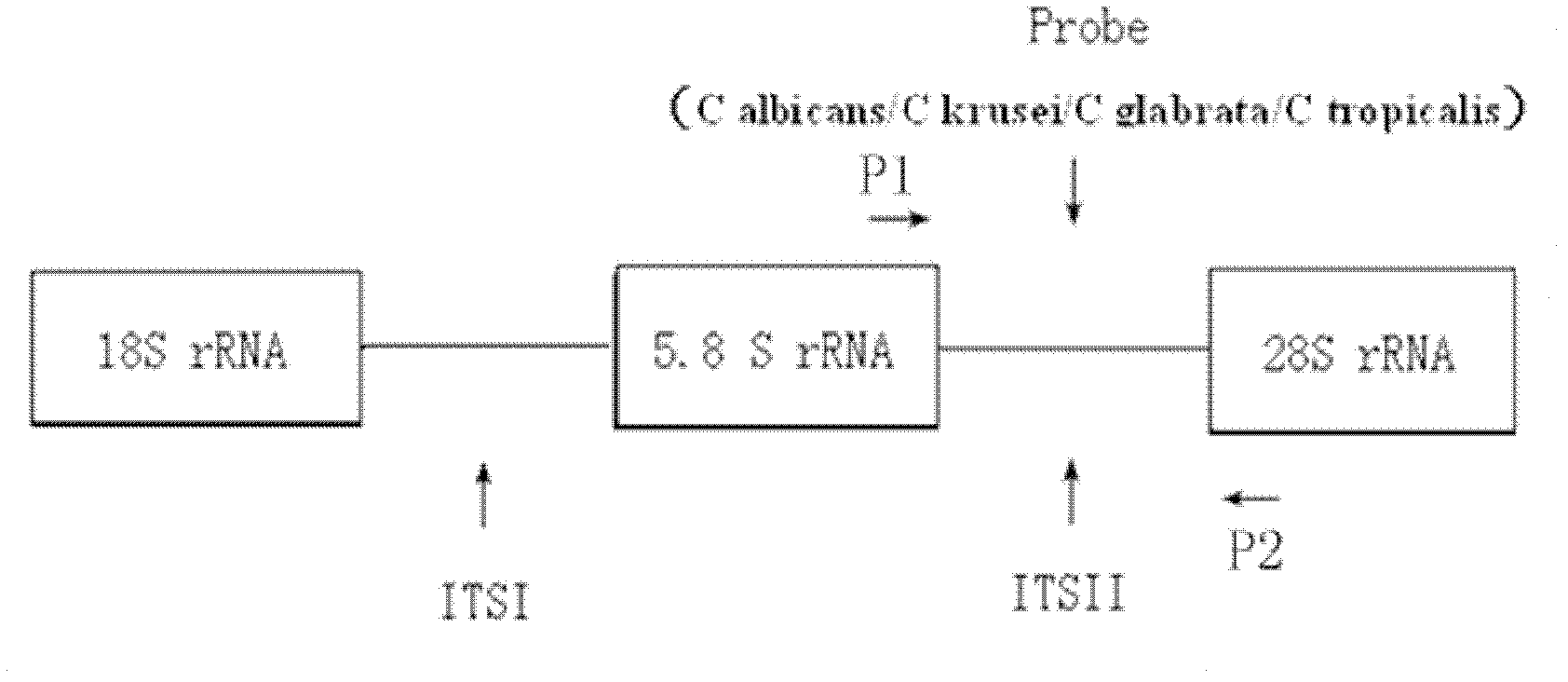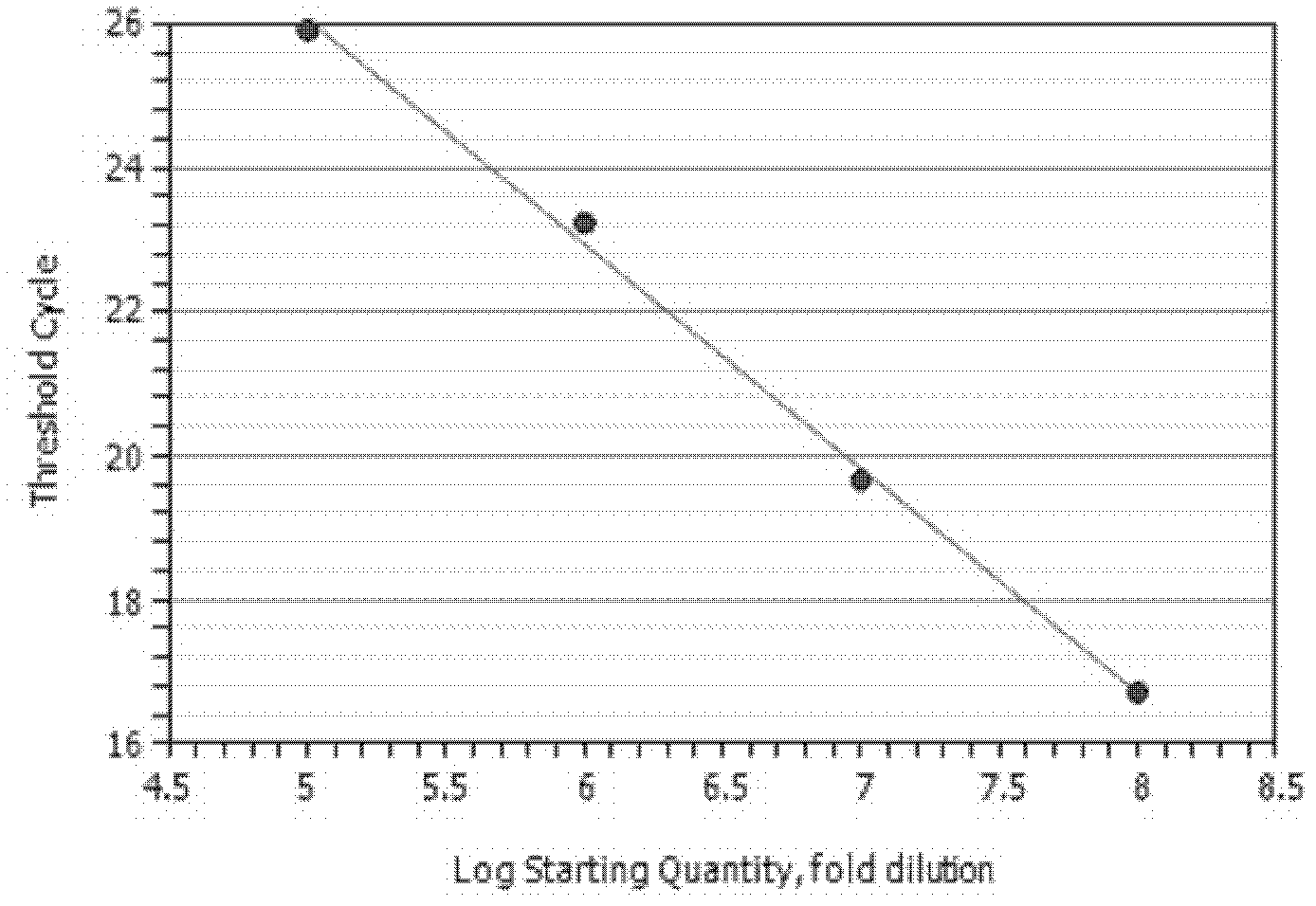Fluorescence quantitative PCR (polymerase chain reaction) universal premier for detecting pathogenic aspergillus, detection probe and kit
A technology for detection kits and detection probes, applied in fluorescence/phosphorescence, biochemical equipment and methods, microbial measurement/inspection, etc., can solve the problems of lack of specificity, low positive rate, difficult to obtain materials, etc., and achieve high sensitivity High specificity and specificity, high specificity and sensitivity, and easy sampling
- Summary
- Abstract
- Description
- Claims
- Application Information
AI Technical Summary
Problems solved by technology
Method used
Image
Examples
Embodiment 1
[0069] The fluorescent quantitative PCR kit that detects pathogenic Aspergillus described in this embodiment includes:
[0070] A. Fungal Universal Primer Sequence:
[0071] Forward primer (P1): 5'~GTGAATCATCGAGTCTTTGAAC~3' (SEQ ID.NO: 1)
[0072] Reverse primer (P2): 5'~TCCTCCGCTTATTGATATGC~3'; (SEQ ID.NO: 2)
[0073] B. 4 kinds of specific fluorescent quantitative PCR primer probe sequences and fluorescent labels, as shown in the following table:
[0074]
[0075] For the gene positioning effect of primers and probes, see figure 1 .
[0076] 3.2 Utilize the synthetic universal primer to amplify four kinds of standard Aspergillus strains to be tested by common PCR,
[0077] The DNA of four kinds of Aspergillus extracted by conventional methods is used as template, the PCR reaction volume is 25ul, the reaction system includes Taq enzyme 0.125ul, 10×Buffer 2.5ul, dNTP 2ul, universal primer (0.1mmol / l) each 1ul, DNA template 1ul , add DEPC water to 25ul. A negative cont...
Embodiment 2
[0084] Embodiment 2: the specificity of multiplex fluorescence quantitative PCR method
[0085] After extracting DNA from standard strains, human whole blood cell DNA and clinically common pathogenic isolates used in this study, amplify them by multiplex fluorescent quantitative PCR according to the detection method described in Example 1 to detect their specificity. sex.
[0086] Various Aspergillus, Candida, standard strain DNA, clinical isolate strain DNA, and human whole blood cell DNA were amplified by multiplex fluorescent quantitative PCR. The Ct values of Aspergillus fumigatus, Aspergillus flavus, Aspergillus terreus, and Aspergillus niger were all ≤35.0, and the identification results were positive, while other Aspergillus, Candida, bacteria (such as Escherichia coli (ATCC35218), Klebsiella pneumoniae (ATCC 700603) ), Enterobacter cloacae (ATCC 700323), Pseudomonas aeruginosa (ATCC 27853), Staphylococcus aureus (ATCC 25922), and Haemophilus influenzae (ATCC 49247))...
Embodiment 3
[0089] Embodiment 3: the sensitivity of multiplex fluorescent quantitative PCR method
[0090] Dilute the spore suspension of Aspergillus fumigatus, Aspergillus flavus, Aspergillus terreus and Aspergillus niger by 10 times: 1×10 7 , 1×10 6 , 1×10 5 , 1×10 4 , 1×10 3 , 1×10 2 , 1×10 1 , 1×10 0 Spores / ml. After routinely extracting DNA, perform multiple fluorescent quantitative PCR amplification, the lowest detection rate is 1×10 2 Spores / ml of the above four Aspergillus species to be tested. Figure 11-14 It is the sensitivity result of detection of Aspergillus by multiplex fluorescent quantitative PCR method. (In the figure, from left to right are 1×10 7 Spores / ml, 1×10 6Spores / ml, 1×10 5 Spores / ml, 1×10 4 Spores / ml, 1×10 3 Spores / ml, 1×10 2 Spore / ml)
PUM
 Login to View More
Login to View More Abstract
Description
Claims
Application Information
 Login to View More
Login to View More - R&D
- Intellectual Property
- Life Sciences
- Materials
- Tech Scout
- Unparalleled Data Quality
- Higher Quality Content
- 60% Fewer Hallucinations
Browse by: Latest US Patents, China's latest patents, Technical Efficacy Thesaurus, Application Domain, Technology Topic, Popular Technical Reports.
© 2025 PatSnap. All rights reserved.Legal|Privacy policy|Modern Slavery Act Transparency Statement|Sitemap|About US| Contact US: help@patsnap.com



